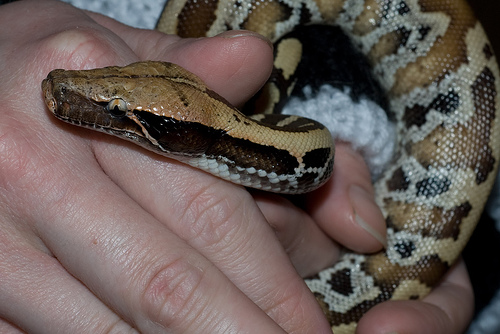A blood python coping with its natural habitat will spend nearly all of it's once again time underwater. While submerged inside a river or stream, the blood python waits for its meal to cross its path. Python curtus would then stalk the targeted prey and ambush it. This aggressive characteristic is clear in other behaviors in the blood python. By way of example, folks who catch blood pythons inside the wild have reported many violent, ill-tempered actions.
Blood Python Snakes

Blood Python Snakes
Wild pythons living near human settlements will be considered to be dangerous pests than as exotic pets. Alternatively, blood pythons which can be raised and bred are usually docile. The people who catch the species Python curtus are generally breeders and collectors of exotic animals. Blood pythons became endangered due to the fact that their beautiful skin is actually in high demand around the exotic leather market.

Blood Python Snakes
 Blood Python Snakes
Blood Python Snakes
The blood python is usually a stocky snake have a tendency to grows to a maximum period of about 3 to 4 feet, just a few large ones reach 8 feet. Like types of snakes, the females are larger than the males. A distinguishing mark on the blood python is a head that changes colors. It's also unusual because it is so thick for its length. The coloration was in blotches of numerous red tinged patterns. These people have a long lifespan of two-and-a-half decades or possibly even longer in captivity. With the responsibility and very long time span associated with having a snake, it is not a conclusion to become made lightly.
 Blood Python Snakes
Blood Python Snakes
You have to obtain a captive born snake for the reason that wild born snakes will often be nervous and aggressive. Well looked after captive bred blood pythons are often placid and docile. Still, they are not beginner snakes. Think of this Southeast Asia native being an "intermediate" snake in difficulty of care.

Blood Python Snakes
A grownup blood python needs an enclosure that is certainly four or five feet long, but a little daughter snake will feel more secure in the smaller enclosure. Snakes are cold blooded animals, that makes it necessary to have heat combined with the cage. This warmth should consist of one end for the other to ensure the snake can come up the temperature which makes it have the best. Warming can be accomplished by way of an under-tank heater, its own heating pad purchased in your pet store. It placed under only half the tank.
The temperature in both ends must be monitored by the use of thermometers. The blood python requires a basking section of 88 to 90 degrees Fahrenheit (about 31-32.5 degrees Celsius) along with the cooler end from the cage maintained at about 78 to 80 degrees (about 22.5-27 degrees Celsius). It should not be permitted to fall below 75 degrees (about 24 degrees Celsius). Your humidity has to be kept at 50 to 60 percent. A substrate (cage floor material) like cypress mulch will help maintain humidity. It could be misted when it dries out. You'll need to be careful to never ensure that it stays too wet or will probably be too humid and become unhealthy with the snake. Newspaper can also be fine to use as a substrate, but you need to pay attention to the humidity. Sources, boatips.com, whozoo.org.